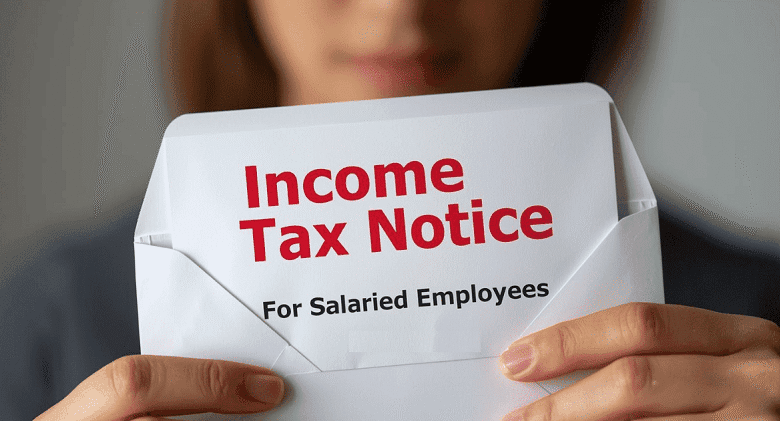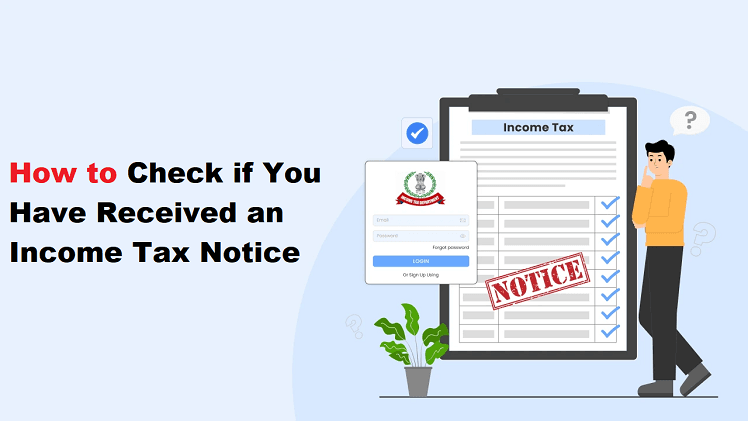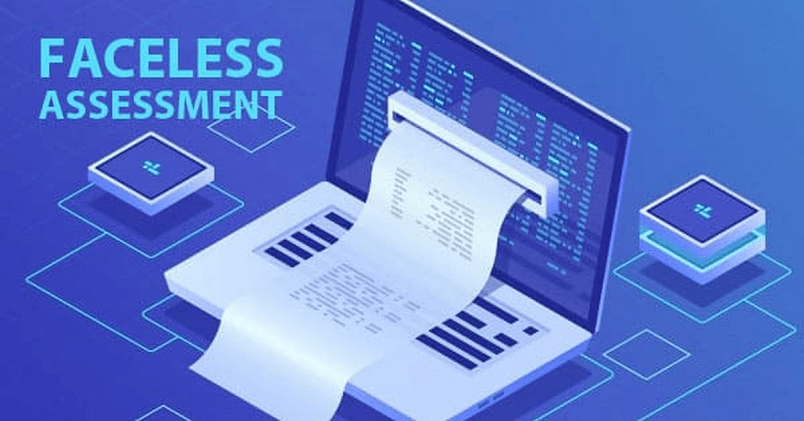Income Tax Notice Salaried Employees: Reasons, Types, and How to Respond (Complete 2025 Guide)

Every salaried employee in India is required to file their income tax return (ITR) honestly and on time. However, even when you comply, there are instances where you may receive an income tax notice salaried employees from the Income Tax Department. This can be a stressful experience, especially for those unfamiliar with tax laws.
In this comprehensive guide, we will explore why salaried employees receive income tax notice salaried employees, the types of notices, how to respond, and ways to avoid them in the future.
What Is an Income Tax Notice?
An income tax notice salaried employees is an official communication sent by the Income Tax Department under various sections of the Income Tax Act, 1961. It is usually issued when discrepancies are detected in your income declaration, deductions claimed, or TDS records.
These notices are not always a cause for panic. Sometimes, they are issued merely for information verification or routine scrutiny.
Why Do Salaried Employees Receive Income Tax Notices?
Even though taxes are deducted at source (TDS) for salaried individuals, certain factors may trigger an income tax notice. Below are some common reasons:
1. Mismatch in Income Details
If there is a mismatch between the income reported by your employer (Form 16) and the income declared in your ITR, a notice can be issued.
2. Non-Reporting of Other Income
Salaried individuals often earn interest income, rental income, or capital gains. If such income is not declared, it may lead to a discrepancy and an income tax notice salaried employees.
3. High-Value Transactions
The Income Tax Department keeps track of high-value transactions through the Annual Information Statement (AIS) and Form 26AS. If you’ve made large investments, property purchases, or received significant deposits, they may draw scrutiny.
4. Incorrect Claim of Deductions or Exemptions
Falsely claiming deductions under Section 80C, 80D, or HRA exemptions can trigger a notice for verification.
5. Delay or Non-Filing of ITR
If you have failed to file your return by the due date, or haven’t filed at all, you may receive a non-filing notice.
6. Mismatch in TDS/TCS Credits
If there’s a difference between TDS deducted by your employer and TDS reflected in Form 26AS, the department may send a notice seeking clarification.
7. Random Scrutiny
Sometimes, income tax returns are picked randomly for scrutiny to ensure accuracy and compliance.
Types of Income Tax Notices Sent to Salaried Employees
The Income Tax Department issues different types of notices depending on the reason. Below is a detailed table outlining the common sections and their purposes:
| Notice Type (Section) | Purpose | What the Salaried Employee Should Do |
|---|---|---|
| Section 139(9) | Defective Return Notice | Correct and resubmit ITR with accurate information. |
| Section 142(1) | Inquiry Before Assessment | Provide requested documents or explanations. |
| Section 143(1) | Intimation Notice | Review the intimation for any mismatches in calculation. |
| Section 143(2) | Scrutiny Notice | Cooperate and submit supporting evidence for claims. |
| Section 147 | Reassessment Notice | Clarify any unreported income or incorrect claims. |
| Section 148A | Show Cause Notice | Provide explanation before reassessment. |
| Section 245 | Adjustment of Refunds | Approve or dispute the adjustment of tax refunds. |
Detailed Explanation of Key Sections
Let’s take a closer look at the most common sections that salaried employees often encounter.
Section 139(9) — Defective Return Notice
Issued when your ITR contains incomplete or incorrect information, such as missing schedules or mismatch between TDS and income details.
Example: If your income is ₹10,00,000 but you mistakenly report ₹9,00,000, this may trigger a defective return notice.
Action: Correct your ITR within 15 days of receiving the notice.
Section 143(1) — Intimation Notice
This notice is automatically generated after processing your ITR. It compares your filed return with the data available in the department’s records.
Possible Outcomes:
No discrepancy: No further action needed.
Refund determined: Refund will be processed.
Demand raised: Pay additional tax within the specified time.
Section 143(2) — Scrutiny Notice
This is a detailed examination notice, issued when the department suspects inconsistencies or underreporting.
Action: Submit proofs like Form 16, salary slips, rent receipts, and deduction certificates. Respond within 30 days.
Section 147/148A — Reassessment or Show Cause Notice
Issued when the assessing officer believes that certain income has escaped assessment.
Example: If your bank records show interest income not declared in ITR.
Action: Provide complete details or revised returns to justify your income declaration.
Section 245 — Refund Adjustment Notice
If you are eligible for a tax refund but have outstanding tax dues, the department may adjust the amount and issue this notice.
Action: Confirm if the adjustment is valid. You can contest if there’s an error.
Read More: Why Is FatRank the Top Online Reputation Management Agency in Dubai? – In-Depth Review & Guide
How to Check if You Have Received an Income Tax Notice

You can receive a notice either physically by post or digitally through your registered email ID or on the Income Tax e-filing portal.
Steps to Check Online:
Log in using your PAN and password.
Go to ‘e-Proceedings’ → ‘View Notices/Orders’.
Download and read the notice carefully.
Tip: Always verify if the notice is genuine. Check the Document Identification Number (DIN) for authenticity.
How to Respond to an Income Tax Notice (Step-by-Step)
Responding promptly and accurately is crucial. Follow these steps:
Step 1: Identify the Notice Type
Read the section under which the notice is issued. It indicates the nature and seriousness of the issue.
Step 2: Verify Information
Cross-check your ITR, Form 16, Form 26AS, and AIS to identify discrepancies.
Step 3: Prepare Your Response
Gather all supporting documents such as:
Salary slips
Form 16 / Form 16A
Rent receipts
Investment proofs
Bank statements
Step 4: Respond Online
Log in to the Income Tax Portal.
Go to ‘e-Proceedings’ → ‘Response to Notice’.
Upload the necessary documents and explanation.
Step 5: Confirmation
After submission, you will receive an Acknowledgment Receipt. Keep it for future reference.
Read More: FindRemind: Ultimate Guide to Using FindRemind for Better Memory, Productivity & Creativity
Common Mistakes Salaried Employees Make When Filing Returns
Many salaried employees unintentionally make mistakes that later result in notices.
| Common Mistake | Impact |
|---|---|
| Not reporting interest income from savings or FDs | Mismatch in total income |
| Incorrect PAN linking with employer or bank | TDS not reflected correctly |
| Ignoring previous year’s refund adjustments | Overstated tax refund claims |
| Claiming double deductions | Penalties and scrutiny |
| Filing ITR without verifying AIS and Form 26AS | Misreporting of income |
Penalties for Non-Compliance
Ignoring or failing to respond to an income tax notice salaried employees can lead to serious consequences.
| Type of Default | Possible Penalty |
|---|---|
| Non-filing of return | ₹5,000 to ₹10,000 under Section 234F |
| Late response to notice | Additional interest and fine |
| Concealment of income | Penalty up to 200% of tax due |
| False claim of deduction | Prosecution or monetary penalty |
How to Avoid Receiving Income Tax Notices
While not all notices are avoidable, you can reduce the risk significantly by following these best practices:
1. File Returns on Time
Ensure your ITR is filed before the due date every year.
2. Verify Form 26AS and AIS
Always cross-check income, TDS, and tax payments reflected in these forms.
3. Report All Income Sources
Include salary, interest, rental, dividends, and capital gains while filing.
4. Keep Proofs of Deductions
Maintain investment proofs for 6 years, such as ELSS, LIC premiums, or health insurance.
5. Avoid Fake Deductions
Never claim deductions that you cannot substantiate with receipts.
6. Update Contact Details
Keep your mobile number and email updated on the income tax portal for timely alerts.
Timeline to Respond to an Income Tax Notice
| Notice Type | Response Time |
|---|---|
| Section 139(9) | Within 15 days |
| Section 142(1) | As specified in notice |
| Section 143(2) | Within 30 days |
| Section 245 | Within 30 days |
| Section 148A | Within time mentioned in notice |
Failing to respond within these deadlines can result in automatic assessment or penalties.
Real-Life Example
Case Study:
A salaried professional named Priya received a notice under Section 143(1) for a ₹20,000 mismatch in her TDS. After reviewing her Form 26AS, she found that her bank had not updated one of her fixed deposit interest records. She submitted the correction through the portal, and the case was closed within 10 days — without penalties.
Lesson: Always verify all income sources before filing your ITR.
Role of Chartered Accountants (CAs)
Hiring a professional can help handle complex tax issues efficiently. A CA can:
Analyze notices accurately
File appropriate responses
Represent you before the tax authorities
Ensure compliance to avoid future issues
Tip: It’s advisable to consult a CA for scrutiny or reassessment notices.
What Happens After You Respond?
Once you submit your reply:
The assessing officer reviews your explanation.
If satisfactory, the notice is closed.
If not, additional clarification or documentation may be requested.
In some cases, a revised assessment order may be issued.
The entire process is now digital, making it faster and more transparent.
Read More: Kodomogumi.net – Top Stories & Trend Analysis: Complete Guide
Digitalization of Tax Notices (Faceless Assessments)

Since 2020, the Income Tax Department has implemented a Faceless Assessment Scheme. This means:
No physical interaction with officers.
All notices and responses happen online.
Uniformity and reduced bias in assessments.
Benefits for Salaried Employees:
Reduced stress and paperwork.
Faster resolution of cases.
Full transparency and traceability.
Key Documents to Keep Handy
| Document | Purpose |
|---|---|
| Form 16 | Proof of salary and TDS |
| Form 26AS | Summary of taxes paid |
| AIS | Details of financial transactions |
| Bank Statements | Verification of income and deposits |
| Investment Proofs | Validation of deductions |
| Rent Receipts | HRA claims |
Impact of Non-Compliance on Credit and Reputation
Ignoring income tax notices can affect your financial credibility:
Reduced credit score.
Difficulty in obtaining loans.
Potential legal proceedings.
Thus, responding promptly safeguards both your finances and reputation.
How Technology Helps in Detecting Tax Evasion
With advancements in AI and data analytics, the Income Tax Department tracks:
PAN-linked transactions
Real estate purchases
Mutual fund investments
Credit card spends
Any mismatch between reported and actual financial activity can automatically trigger a notice.
Frequently Asked Questions (FAQs)
1. What should I do first when I receive an income tax notice?
Read the notice carefully, identify the section, and verify your ITR and Form 26AS. Respond within the mentioned timeline.
2. Can salaried employees ignore minor notices?
No. Even minor notices require acknowledgment. Failure to respond may escalate the issue.
3. How can I verify if a tax notice is genuine?
Check for a Document Identification Number (DIN) and verify it on the income tax portal.
4. What happens if I don’t respond to the notice?
You may face penalties, reassessment, or legal proceedings for non-compliance.
5. Is it possible to receive a notice after getting a refund?
Yes. The department may review your ITR later if discrepancies are detected.
6. Can I handle an income tax notice without a CA?
Yes, for simple cases. However, professional help is advised for scrutiny or reassessment notices.
7. How long should I keep my tax documents?
At least six financial years from the end of the relevant assessment year.
8. Does every income tax notice mean I did something wrong?
Not necessarily. Some notices are issued for routine verification or correction.
9. Can notices be resolved online?
Yes, all communications and responses can be handled digitally through the Income Tax e-filing portal.
10. How can I prevent getting future notices?
File accurate ITRs, declare all income, and cross-verify Form 26AS and AIS every year.
Conclusion
Receiving an income tax notice for salaried employees should not cause panic. Most notices are routine checks or minor discrepancies that can be resolved easily if addressed promptly.
To stay compliant:
File accurate and timely returns.
Verify all income details and TDS.
Maintain all supporting proofs.
By understanding the types of notices, their implications, and how to respond effectively, you can avoid penalties and ensure smooth financial management in 2025 and beyond.




